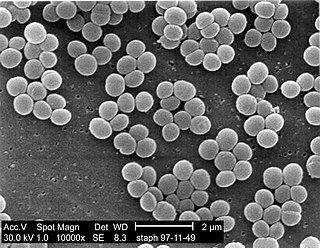Lysostaphin is a Staphylococcus simulans metalloendopeptidase. It can function as a bacteriocin (antimicrobial) against Staphylococcus aureus.

Staphylococcus is a genus of Gram-positive bacteria in the family Staphylococcaceae from the order Bacillales. Under the microscope, they appear spherical (cocci), and form in grape-like clusters. Staphylococcus species are facultative anaerobic organisms.
Streptomyces reticuliscabiei is a streptomycete bacterium species that is associated with netted scab in potatoes. Its type strain is CFBP 4517T. It is considered to be part of a cluster together with S. turgidiscabies, however they cause different diseases, the former involved in common scab.
Staphylococcus pseudintermedius is a gram positive coccus bacteria of the genus Staphylococcus found worldwide. It is primarily a pathogen for domestic animals, but has been known to affect humans as well. S. pseudintermedius is an opportunistic pathogen that secretes immune modulating virulence factors, has many adhesion factors, and the potential to create biofilms, all of which help to determine the pathogenicity of the bacterium. Diagnoses of Staphylococcus pseudintermedius have traditionally been made using cytology, plating, and biochemical tests. More recently, molecular technologies like MALDI-TOF, DNA hybridization and PCR have become preferred over biochemical tests for their more rapid and accurate identifications. This includes the identification and diagnosis of antibiotic resistant strains.
Streptomyces cheonanensis is a bacterium species from the genus of Streptomyces which has been isolated from radish growing soil in Cheonan in Korea.
Streptomyces ferralitis is a Gram-positive, aerobic bacterium species from the genus of Streptomyces which has been isolated from ultramafic soil in New Caledonia.
Streptomyces hainanensis is a bacterium species from the genus of Streptomyces which has been isolated from soil in from the island Hainan in China.
Streptomyces lunalinharesii is a chitinolytic bacterium species from the genus of Streptomyces which has been isolated from soil in Brazil.
Streptomyces radiopugnans is a halotolerant and radiation resistant bacterium species from the genus of Streptomyces which has been isolated from radiation polluted soil from the Xinjiang Province in China.
Streptomyces scopuliridis is a bacterium species from the genus of Streptomyces which has been isolated from woodland soil from Rainbow Bluff in Lynn in Alabama in the United States. Streptomyces scopuliridis produces bacteriocins, desotamides B, desotamides C, desotamides D, sesquiterpenoids and herbicidins.
Streptomyces sodiiphilus is an alkaliphilic bacterium species from the genus of Streptomyces which has been isolated from a muddy sample from the Chaka salt lake in the Qinghai Province in China.
Streptomyces sparsus is a bacterium species from the genus of Streptomyces which has been isolated from saline and alkaline soil in the Qinghai Province in China.
Microbacterium mangrovi is a Gram-positive and non-spore-forming bacterium from the genus Microbacterium which has been isolated from mangrove soil from Tanjung Lumpur in Malaysia.
Novosphingobium malaysiense is a Gram-negative, rod-shaped and non-spore-forming bacterium from the genus Novosphingobium which has been isolated from mangrove soil from the Tanjung Lumpur river in Pahang in Malaysia.
Mumia is a bacterial genus from the family Nocardioidaceae.
Mumia flava is a bacterium from the genus Mumia which has been isolated from mangrove soil in Kuantan, Malaysia.
Barrientosiimonas is a genus of bacteria from the family Dermacoccaceae.
Sinomonas humi is a Gram-positive and non-motile bacterium from the genus Sinomonas which has been isolated from mangrove forest soil from the Tanjung Lumpur forest in Malaysia.
Intrasporangium is a genus of Gram positive, nonmotile bacteria. The genus name refers to the mycelium of the type strain forming intercalary vesicles that were originally identified as spores. However, no spores have been observed in later studies. The family Intrasporangiaceae is named after the genus, and Intrasporangium is the type genus for the family.
Intrasporangium flavum is a species of Gram positive bacteria.
